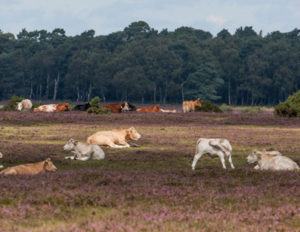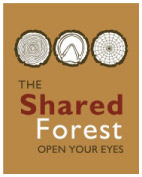The Animals
The ponies, cattle, donkeys and sheep are all owned by local people, who choose to use the common rights attached to parcels of land they occupy by ownership, rent or sharing. The mix of livestock breeds and species has always been part of the New Forest scene and is vital the maintaining the landscape and its cultural heritage. The New Forest pony is, of course, the most famous. But not all of the ponies are registered New Forest ponies, but you will also see Shetlands, Exmoor, and coloured ponies. Grazing the New Forest from birth gives the animals great hardiness and a balanced temperament, which become very sought after traits when the youngstock are sold off the New Forest to their new owners worldwide.
The basic needs of commoners’ animals and seasonal changes in the Forest itself dictate each year’s calendar of commoning activities. The turnout of stallions in early summer means, for example, that foals being to arrive in spring the following year, and have a few months suckling on the Forest before the round-ups and sales in the autumn. Every month brings its own tasks for commoners – getting these done around their normal daily lives of work and family. We hope that this portrayal of the commoning year gives a valuable insight into the real New Forest and the commitment of the animals’ owners.
More than just ponies

The Animals
Commoners own a range of animals to graze the Forest. Whilst ponies tend to be largest in number, there is also a significant number of cows, as well as pigs during the “pannage” period, and some sheep and donkeys. The mix of livestock is important because they graze differently and have different impacts on the soil and vegetation of the Forest, and this variety produces important environmental outcomes. They all have a role in maintaining the New Forest landscape and cultural heritage. It is up to each commoner to take decisions on the animals they turn out within the rights they possess, to keep an eye on them and provide any extra care they might need.
The needs of the animals (and the weather) dictate commoners’ activities and events through the year. You can scroll down for a description of the Commoning Year month-by-month.

Ponies
The New Forest Pony is now a rare breed, and the Breed Society has worked hard and meticulously to retain as many bloodlines as possible. The “Forester” is supremely adapted to the local environment, and able to thrive on what fodder the New Forest offers and the weather they are subjected to. They happily graze all terrain from salty marshland and valley mire, to dry heath and woodland. Things like holly and gorse are important parts of their varied diet. Despite this hardiness they are also great performers, doing well in a multitude of equestrian disciplines. They really are the ideal all-round pony.
Whilst most of the ponies grazing the New Forest and 90% of the foals registered each year with the Breed Society are pure-bred New Forest, there are also several other breeds out grazing. The Shetlands are particularly noticeable, as are the few coloured ponies (which also tend to sell well). Commoners will sometimes turn out geldings to graze and, of course, the year’s carefully selected New Forest stallions in early summer. Every one contributes to the grazing and the cultural heritage. It is for each commoner to decide what is the best way to exercise their rights, according to their own needs and the needs of their animals.

Cows
The continuation of cattle grazing is essential to the biodiversity of the New Forest. Soil poaching by cows in the grazed woodlands is essential to maintaining the habitat for some of Britain’s rarest species. Cattle, however, also require a high commitment from their owners, with special requirements for TB testing and ear-tagging each year and often needing high levels of care. It is hard, therefore, for modern day commoners to keep cattle unless they work very close to where they graze and have a sympathetic employer. To a large degree this means that cows are kept mostly by commoners who are also farmers or otherwise work in local forestry and agriculture. There are no longer any dairy cows on the New Forest, and there are just a few that are finished for beef. Most bred here will be sold on after their Forest grazing for finishing by beef farmers away from the New Forest. Calving on the open Forest is not just a core part of the New Forest scene and an important component of the high welfare standards intrinsic to extensive commoning systems .

Donkey
Commoners have traditionally kept donkeys as working animals, of real value to daily tasks. Nowadays they are popular for purchase as domesticated livestock, and are sold alongside ponies at the Beaulieu Road Sales. They are, however, very few in number with just a few hundred across the whole of the New Forest
Donkeys are less hardy than New Forest ponies and, therefore, tend to spend more time on commoners’ holdings than the ponies, who are normally left to graze freely all year round.

Pig
Pigs are mostly allowed on the Forest only for a few weeks each year, decided every Autumn by the Court of Verderers. They do a valuable job of eating the acorns, which are poisonous to the ponies and cattle. Acorns are a serious problem because, unlike ragwort, ponies do like to eat them. When the acorn crop is heavy the Verderers may choose to extend the time that the pigs are out, well into December.

Sheep
text in here

Caring for the Animals

Commoning year
July
Commoners and their animals scrub up for the New Forest Show, and the CDA gets busy branding house nameplates for sale at the Show.
Some will be making hay while the sun shines, saving money from having to buy in winter hay, some training their young ponies, and others welcoming people to camp in their fields.
See how we care for the animals all year around
View Full Commoning Year
Members Login
 Latest Tweets
Latest Tweets
Follow us
@realnewforest 4h
Icilibus sam quas aut eriatem nume corepta auta conet officaborem quodi corepta auta conet officaborem quodi apernat ectlpa dolorpiaecus.
@realnewforest 4h
Icilibus sam quas aut eriatem nume corepta auta conet officaborem quodi corepta auta conet officaborem quodi apernat ectlpa dolorpiaecus.
@realnewforest 4h
Icilibus sam quas aut eriatem nume corepta auta conet officaborem quodi corepta auta conet officaborem quodi apernat ectlpa dolorpiaecus.
With thanks for support from




